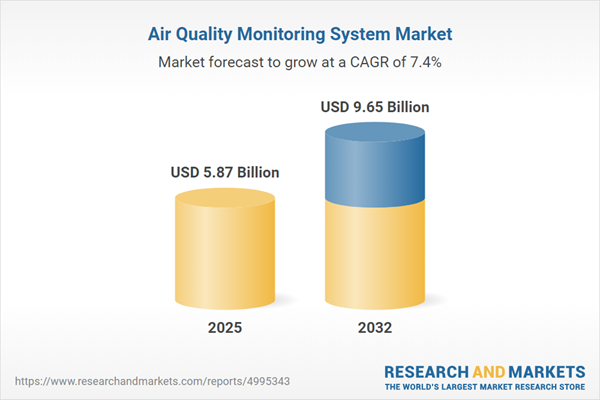Speak directly to the analyst to clarify any post sales queries you may have.
The global air quality monitoring system market is advancing rapidly, supported by transformative technologies and evolving regulations. Stakeholders across industries are adopting innovative solutions to address mounting environmental and compliance demands in both urban and remote environments.
Market Snapshot: Air Quality Monitoring System Market
The Air Quality Monitoring System Market grew from USD 5.45 billion in 2024 to USD 5.87 billion in 2025. Forecasts indicate continued expansion at a CAGR of 7.38%, reaching USD 9.65 billion by 2032. Robust growth is fueled by increasing industrial and urban activities, stringent environmental mandates, and widespread technology adoption across global regions.
Scope & Segmentation
This report provides an in-depth analysis and forecast of the air quality monitoring system market, encompassing detailed segmentation by products, deployment strategies, applications, end users, pollutant types, and geographical regions. The coverage includes emerging innovations, competitive dynamics, and regulatory impacts influencing buying decisions.
- Product Types:
- Hardware – Analyzers, Display Units, Sensor Modules, Transmitters
- Services – Consulting, Installation, Maintenance
- Software – Cloud Based, On Premise
- Deployment Modes:
- Fixed
- Portable
- Applications:
- Indoor – Commercial, Industrial, Residential
- Outdoor – Environmental Monitoring, Research
- End Users:
- Commercial
- Government
- Healthcare
- Industrial
- Residential
- Pollutant Types:
- Gas
- Particulate
- Regions:
- Americas (United States, Canada, Mexico, Brazil, Argentina, Chile, Colombia, Peru)
- Europe, Middle East & Africa (United Kingdom, Germany, France, Russia, Italy, Spain, Netherlands, Sweden, Poland, Switzerland, United Arab Emirates, Saudi Arabia, Qatar, Turkey, Israel, South Africa, Nigeria, Egypt, Kenya)
- Asia-Pacific (China, India, Japan, Australia, South Korea, Indonesia, Thailand, Malaysia, Singapore, Taiwan)
- Leading Companies Profiled:
- Thermo Fisher Scientific Inc., Teledyne Technologies Incorporated, Siemens AG, Horiba, Ltd., ABB Ltd., AMETEK, Inc., Honeywell International Inc., Emerson Electric Co., Danaher Corporation, Agilent Technologies, Inc.
Key Takeaways
- Technology convergence in sensor miniaturization and data analytics is transforming monitoring efficiency, enabling proactive environmental management across industry verticals.
- Stringent standards and open data initiatives are accelerating public-private partnerships and interoperability, enhancing scalability and stakeholder engagement.
- Flexible deployment strategies, combining fixed and portable systems, allow organizations to address both ongoing surveillance and spot assessments tailored to varied settings.
- Growth in indoor monitoring reflects heightened concern for workforce health and regulatory compliance in both commercial and residential sectors.
- Software integration, utilizing AI and machine learning, is making real-time analytics and predictive alerts more accessible for a broad range of users.
- Competitive differentiation is expanding beyond hardware to value-added services, such as consulting and performance-based contracts, strengthening market positioning.
Tariff Impact and Supply Chain Dynamics
Recent tariff adjustments in the United States are prompting suppliers to revisit cost structures and sourcing strategies. Key hardware components like analyzers, sensors, and transmitters are affected by increased duties, impacting procurement and deployment timelines. In contrast, software and data management offer relative stability, serving as a cost buffer against trade-driven disruptions. As a result, companies are pursuing localized production, dual-sourcing, and regional trade agreements to mitigate volatility and protect competitive margins.
Methodology & Data Sources
This report integrates quantitative research from global market surveys and executive interviews with qualitative analysis of regulatory filings, technical papers, and industry input. Findings were validated through triangulation across proprietary datasets and review by subject-matter experts, ensuring actionable and credible insights for senior leadership.
Why This Report Matters
- Enables strategic planning by highlighting trends, risks, and emerging opportunities in the air quality monitoring system market.
- Helps benchmark against top competitors through exhaustive segmentation and technology mapping.
- Supports resilient procurement and compliance decisions amid regulatory and tariff shifts across regions.
Conclusion
The air quality monitoring system market is characterized by technological advancement, regulatory momentum, and rising demand for integrated solutions. Companies that adapt through innovation and agile strategies are well-placed to achieve sustained value and compliance in a complex global landscape.
Additional Product Information:
- Purchase of this report includes 1 year online access with quarterly updates.
- This report can be updated on request. Please contact our Customer Experience team using the Ask a Question widget on our website.
Table of Contents
3. Executive Summary
4. Market Overview
7. Cumulative Impact of Artificial Intelligence 2025
Companies Mentioned
The companies profiled in this Air Quality Monitoring System market report include:- Thermo Fisher Scientific Inc.
- Teledyne Technologies Incorporated
- Siemens AG
- Horiba, Ltd.
- ABB Ltd.
- AMETEK, Inc.
- Honeywell International Inc.
- Emerson Electric Co.
- Danaher Corporation
- Agilent Technologies, Inc.
Table Information
| Report Attribute | Details |
|---|---|
| No. of Pages | 196 |
| Published | October 2025 |
| Forecast Period | 2025 - 2032 |
| Estimated Market Value ( USD | $ 5.87 Billion |
| Forecasted Market Value ( USD | $ 9.65 Billion |
| Compound Annual Growth Rate | 7.3% |
| Regions Covered | Global |
| No. of Companies Mentioned | 11 |









